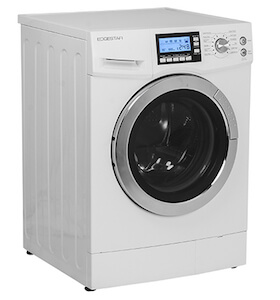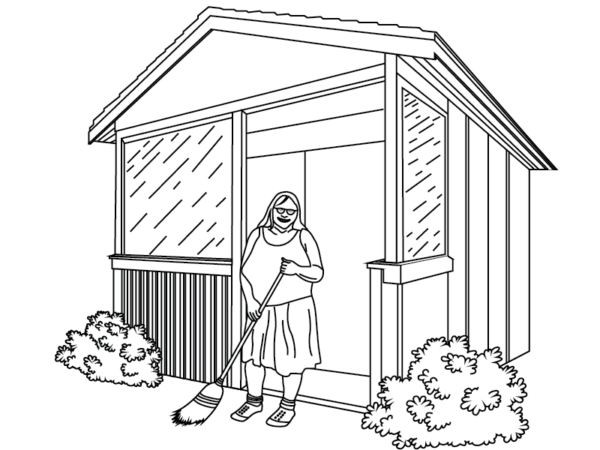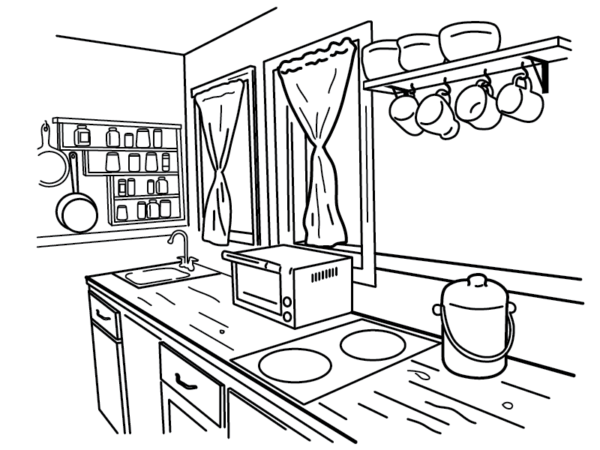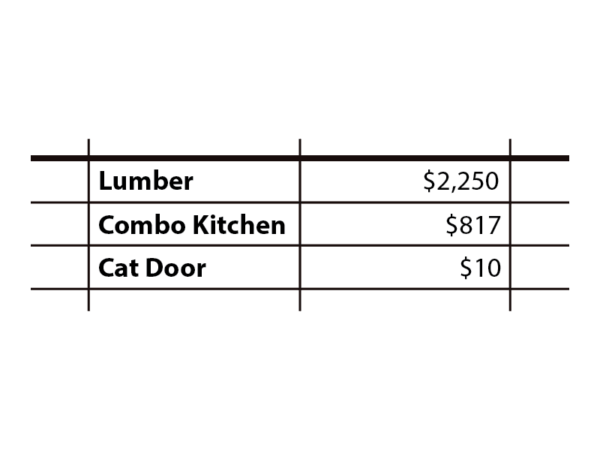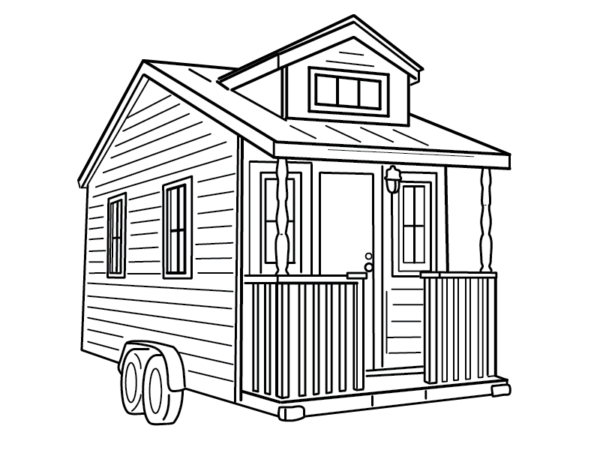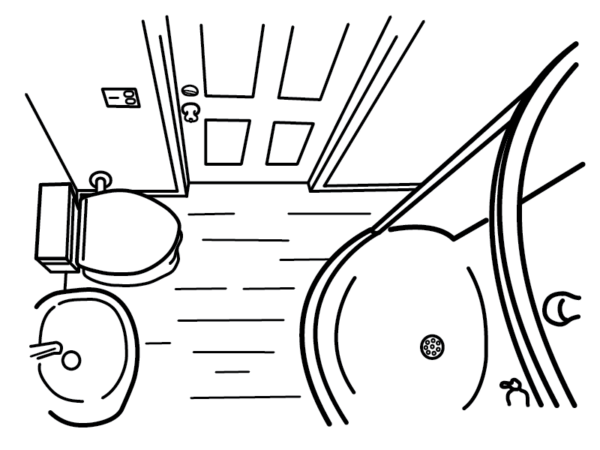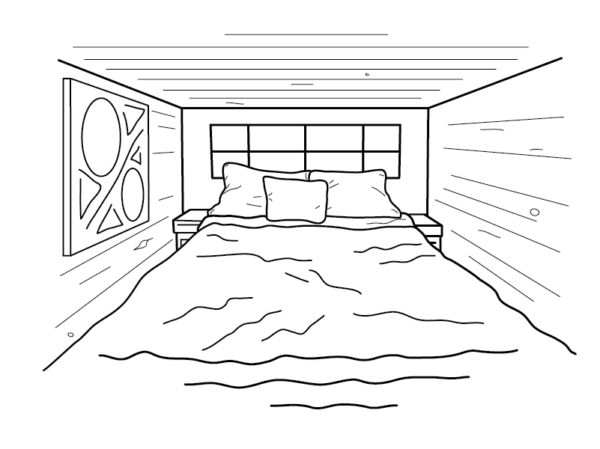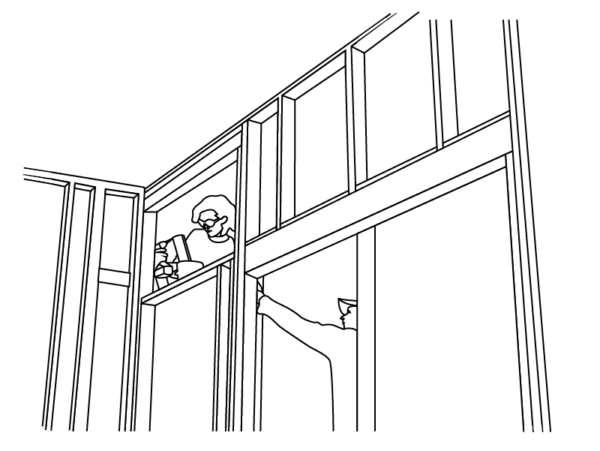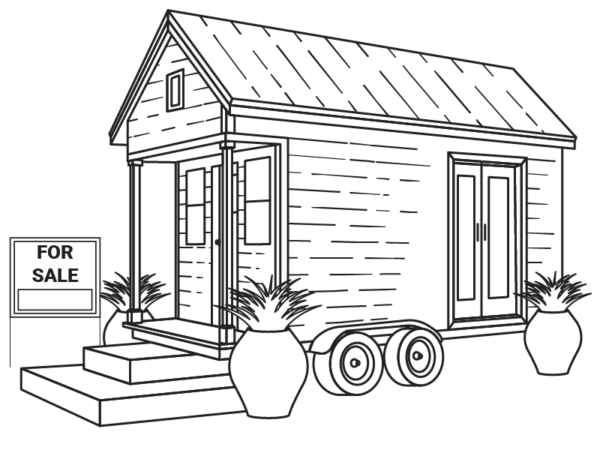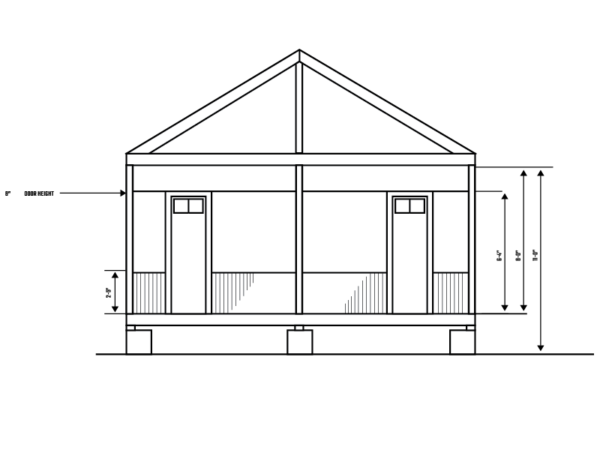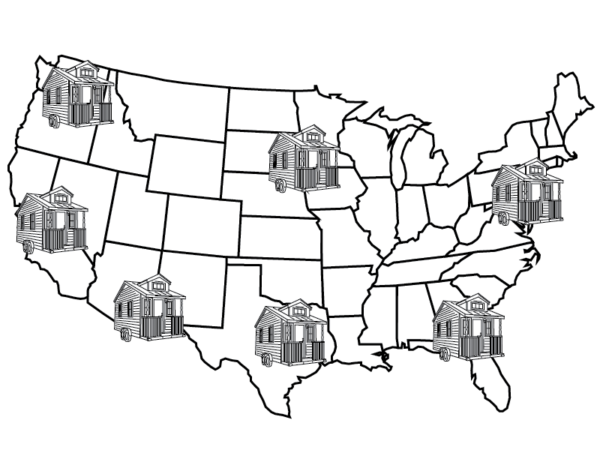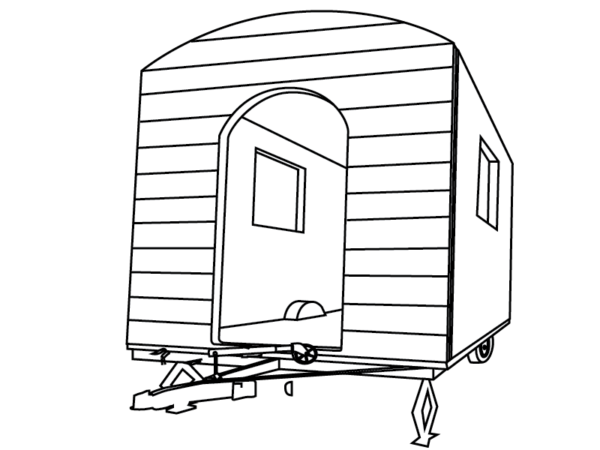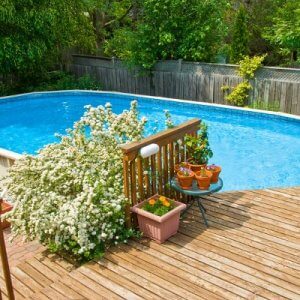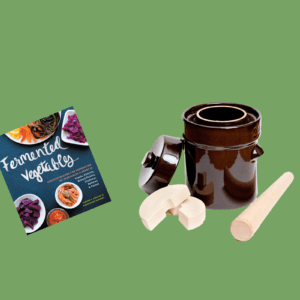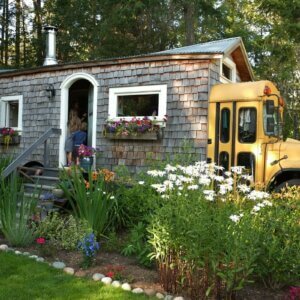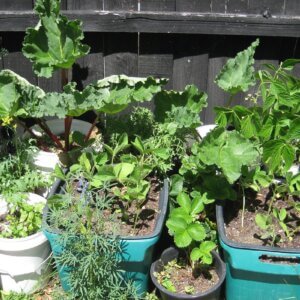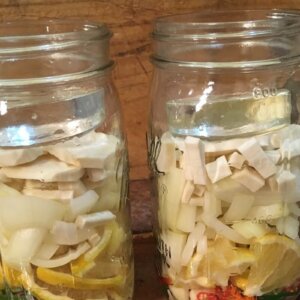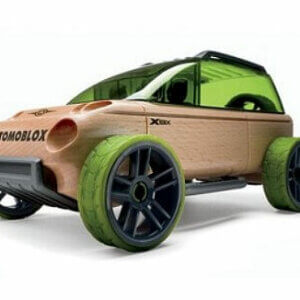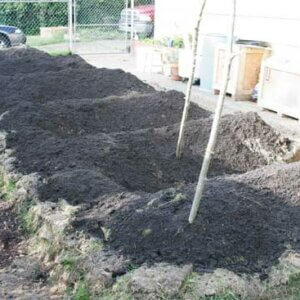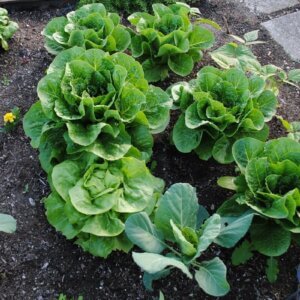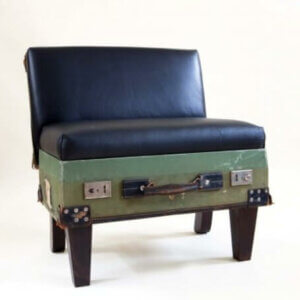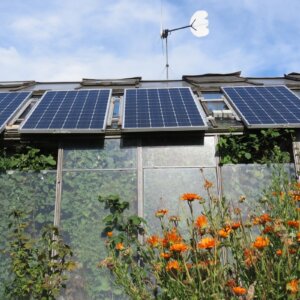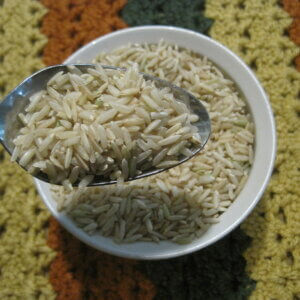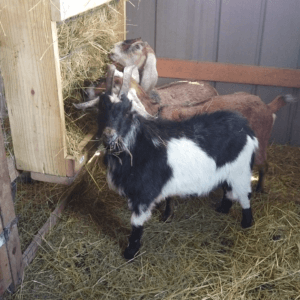The design of a tiny house kitchen is a personal matter. Your final design will depend on your own individual needs and the needs of those who’ll live with you.
If you want to build or buy a tiny house but don’t know a lot about design, there are some things you should look out for. While you’ll only realize some of the complexities once you start building, several critical mstakes can be avoided from the start.
This guide is meant to refine your thought process for your kitchen design, so you can make as few errors as possible.
Before we get into the meat of it, here are three things about designing a tiny house to keep in mind:
- Everything is a compromise. Design is like creating a puzzle—one small change can drastically alter a whole design.
- There is no right or wrong. The tiny house movement is about throwing convention out the window, so as long as it’s safe, will last, and works for you, go for it.
- That aesthetic ‘mistake’ doesn’t look as bad as you think it does. Just breathe and let it be.
These questions will help guide your thoughts on the design process.
What’s The Best Power Source For Your Tiny House Kitchen?
Electricity
The advantages of electricity are: It’s the cheapest to set up, the appliances that require electricity are abundant and cheap, and you can plug in almost anywhere on the grid.
The disadvantage of electricity is: Cooking with it takes up too much power for the average tiny house. If you are planning on going off-grid, this might not be the best option for you, unless you want to go solar and live in the desert.
However, if you can find a spot with a high-powered grid hook up that can pump out plenty of volts, go for it. Now, if you plan to just run a 20 or 30 amp extension cord into someone’s house, like many tiny house owners do, an electric stove isn’t a good option for you. Your high-voltage stove will suck up the entire energy output of your cord and the rest of your appliances will overload the system. It might work if you only use one thing at a time, but who wants to do that? A small-to-medium sized energy-star electric refrigerator is a better choice.
3.1 Cu. Ft. Energy Star Fridge/Freezer
A three-foot high unit with a freezer for a very reasonable price.
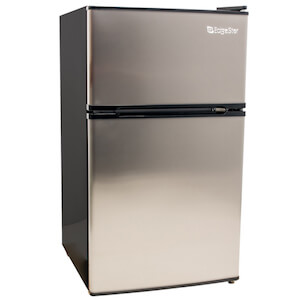
Solar
Solar has the advantage of providing “free” electricity once set up, so you’ll be able to use those cheap and abundant electrical appliances. However, solar has a high start-up cost. The specific cost is highly dependent on your needs and where you live, but for a solar system that aims to just cover lighting and computers, expect to pay around two thousand dollars.
One major thing that’s held some back from investing in solar is the fact that the technology improves every year with better efficiency, greater storage capacity, and reduced cost. Meaning, if you go out and buy a slam-dunk solar system, in a few years you might be able to buy the same system for half the cost. Also, the region you decide to live in will affect how much power you can draw—for instance, at Insteading HQ in the Pacific Northwest, you have to worry about the long winter months of limited sun exposure. Anyone going solar near Seattle would need a large battery storage capacity.
Natural Gas Or Propane
Natural gas is a good option if you can find a property with a hookup. You can live off-grid and use propane, but Propane is good for off-grid but propane appliances are significantly more expensive and the price of propane fluctuates. Still, if you can absorb the initial cost and deal with the changing prices, over the long run propane is cheaper than electricity.
To review, electric systems are good for refrigeration, lighting, and powering your computer devices propane and gas are better suited for high-energy appliances like stoves and heaters.
Because of this, we recommend a hybrid of these systems. Gas can take care of the power-hungry appliances like the cooking stove to reduce the stress on your power hook up, and electricity can take care of the lower-power requirements. How often do you cook, and for how many people?
These questions will help determine many aspects of your kitchen design—if it’s just you, electricity might be a decent option since there won’t be as much of a strain on your power supply. The more people you have to cook for, the larger the kitchen will need to be,the larger the appliances will need to be, the larger your dining area will need to be, the larger your storage capacity will need to be, and of course, the more power you’ll need.
How Will You Get Water?
Are you going to hook up to the grid? Are you going to collect rain water? Will you simply get a two gallon jug and gravity feed it to your sink?
Your decision on this matter can have a big impact on the design of your kitchen. If you want plumbing, you have to make sure you plan around that and make room for the pipes. the placement of your tiny house will also need, at a minimum, a hose to hook up to.
If you want to capture rainwater, you need to have a holding tank to store water. The tank should live somewhere with clean air, clean rain, and minimal debris. On top of that, you need to make sure your roofing material is safe for water catchment. There’s no clear consensus on which material is the best to use, however, be mindful of any material that may rust, or might be porous enough to grab onto things you don’t want to be drinking. This rather dense article is a good jumping off point if you want to dive into the rabbit hole of finding the best water catchment roofing material.
The gravity fed jug system, with no space for plumbing needed, is obviously the easiest design-wise, and cheapest, but it comes at a cost of having to adjust your lifestyle to depend on a gravity-fed two-gallon jug for all of your sink needs.
What Is Your Budget?
You could easily spend five thousand dollars on kitchen appliances—or with a little effort and patience, spend less than five hundred. Neither option is more valid than the other; it just depends on your needs and values. If you are tight on time but not tight on budget, new items are definitely a consideration.
When deciding between low or high quality, expensive or cheap, find a happy compromise. You don’t want to have to repurchase cheap items because they broke after less than a year of use, but you also don’t need to buy the latest two-thousand dollar High Definition LED Refrigerator Entertainment System 5000. So, we recommend that you check out CompactAppliance.com for tiny house appliances. They offer a decent middle-ground price-wise.
Sometimes buying new is best. But one of the biggest factors driving the tiny house movement is that it embraces the community-based culture that has arisen with the popularity of the internet. Trends like Craigslist, free stores, trade-based services are all in synergy with the ideals of the tiny house movement. Get acquainted with your neighbors and see if you can help each other.
How Much Food Storage Do You Need?
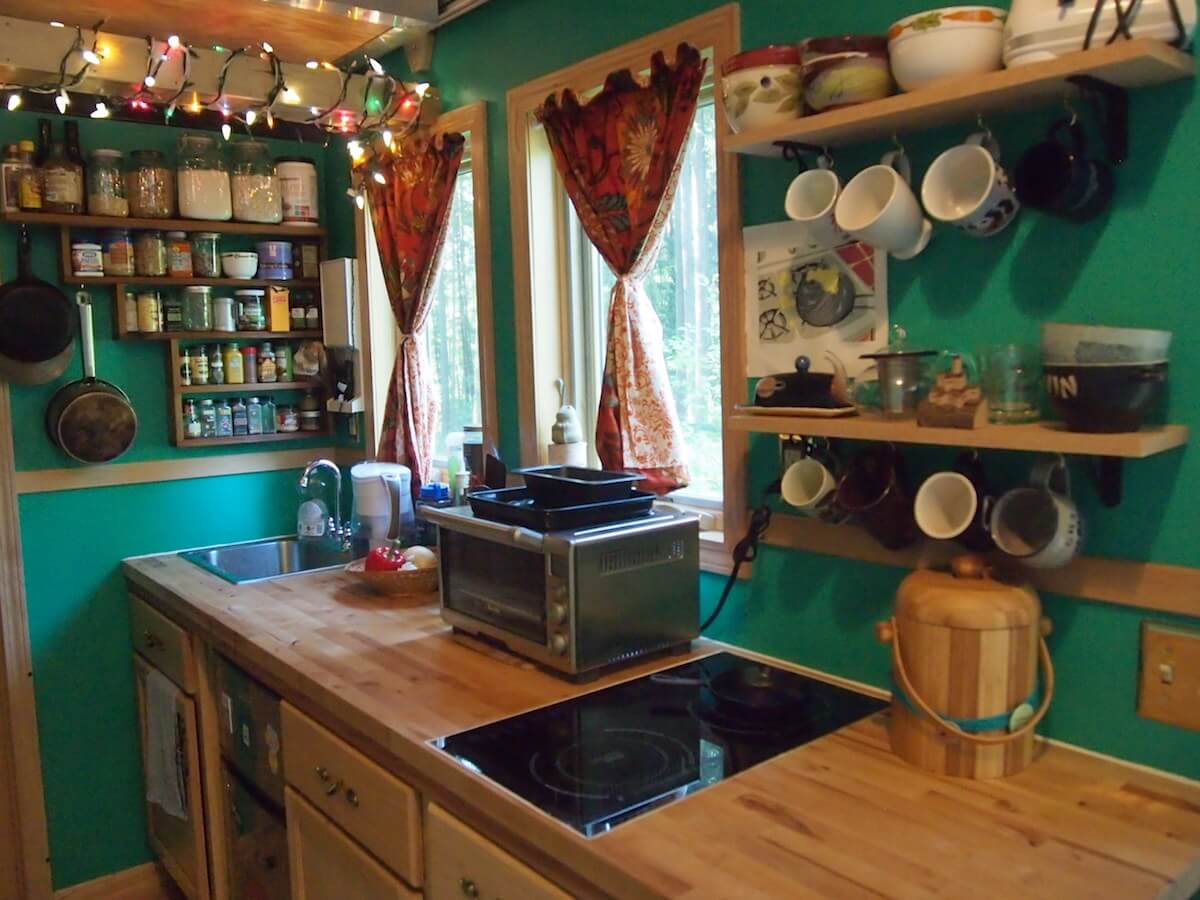
This goes back to how many people your kitchen will need to serve. Obviously, the more people, the more storage. But the type of diet you adhere to and where you live will also affect how you will store your food.
If you eat a strictly fresh diet you will want to maximize your cooled storage space; if you eat mostly canned or dry foods, refrigeration isn’t as much of an issue as larger cabinet space.
If you live in town, frequent trips to the store are more practical, so storage isn’t quite as big of a deal. If you live out in the country you will probably want to limit your trips to the store. If you live on a farm your food may be right outside.
Do You Need a Dishwasher?
If you’re perfectly fine eating freeze-dried powdered meal replacement food sitting directly on the forest floor and cleaning the one jar you used to make it in in a neighboring stream, you don’t need a dishwasher. Most people prefer to eat on dishes. In a large space, it’s no problem to let dishes pile up for a few days. In the limited space of the tiny house, this isn’t an option. Doing the dishes right after you eat isn’t that big of an adjustment. Try it, and you may find that a dishwasher isn’t necessary. On the other hand, dishwashers are incredibly convenient.
You’ll find many options for dishwashers that are compatible with tiny houses, here’s one popular version.
SPT Countertop Dishwasher
Just under two feet high, this sturdy unit with a stainless steel interior connects to your kitchen faucet.
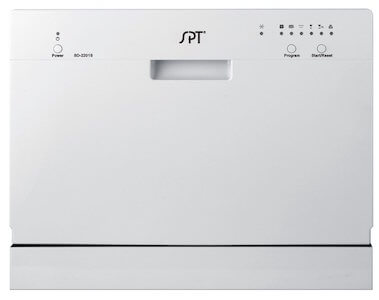
How Large Does Your Dining Room Need To Be?
Are you, like me, satisfied with sitting on the floor while you eat? If not, or if you have a partner who is not, you will need a dining area to eat your home-cooked meals. If you have a living area designed into your house, you could use that as your dining area; you could also build your food prep station into a convertible dining area. There’s loads of possibilities out there, but the best ideas include a fold-out table system. Foldout tables are easy to build on your own, but if you’re not up to it, you can buy cheap options.
Furinno Wall-Mounted Desk
Gives you two feet of eating space when expanded—otherwise takes up barely any room. The brace allows it to hold up to 20 lbs.
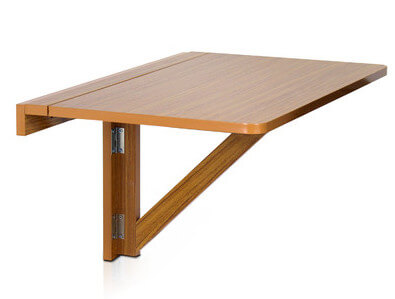
Are You Adding A Washer And Dryer?
“Wait,” you might be saying, “washer and dryers aren’t part of the kitchen!” You are totally right, they’re usually in the garage or basement. But have you ever seen a tiny house with a garage or basement? Exactly.
The kitchen and bathroom are the best places for your washer and dryer, because they already have plumbing lines set up. Depending on your design and which area has more free space, you will want to put it in one of these spaces.
Washer and dryers are not a necessity for a tiny house. But they’re convenient, and unlike dishes, only the most patient person will be willing to do their laundry in the sink. ; You could take your laundry to a local laundromat, but, in the long run, that’s going to cost you a lot of time and money.. If you decide to go this route, I highly recommend a washer/dryer combo. Like most appliances these range from $100 to $2,500.
You’ll have to choose from two types of washer/dryers : vented or unvented. Vented units have a higher capacity and work quicker, but are large and need a hole in the wall. Unvented units are smaller and more compact. Instead of taking air from the room and pumping it in and out of the system, an unvented dryer G-forces to squeeze the water out and deposit it into a reservoir. Most tiny-housers use unvented.
EdgeStar Ventless Washer Dryer Combo
This three-foot-high, two-foot-wide machine washes up to 15 lbs. of clothes per load.
Another interesting idea is this primitive hand-crank model.
Those questions should help guide you in your process of figuring out what you think you want. But what about whittling what you think you want down to what you actually need?
Road-Testing Your Kitchen Plan
Cut Out Unnecessary Kitchen Stuff
Make a list of kitchen essentials, cut half of them. Take that list and allow yourself to use only those items for a week. Pretending you have a tiny house and finding out it’s not for you is a lot cheaper than building/buying one and finding out the same thing. Comment on this article afterwards and tell me how your experiment went!
Make A Physical Replica Of Your Kitchen Space
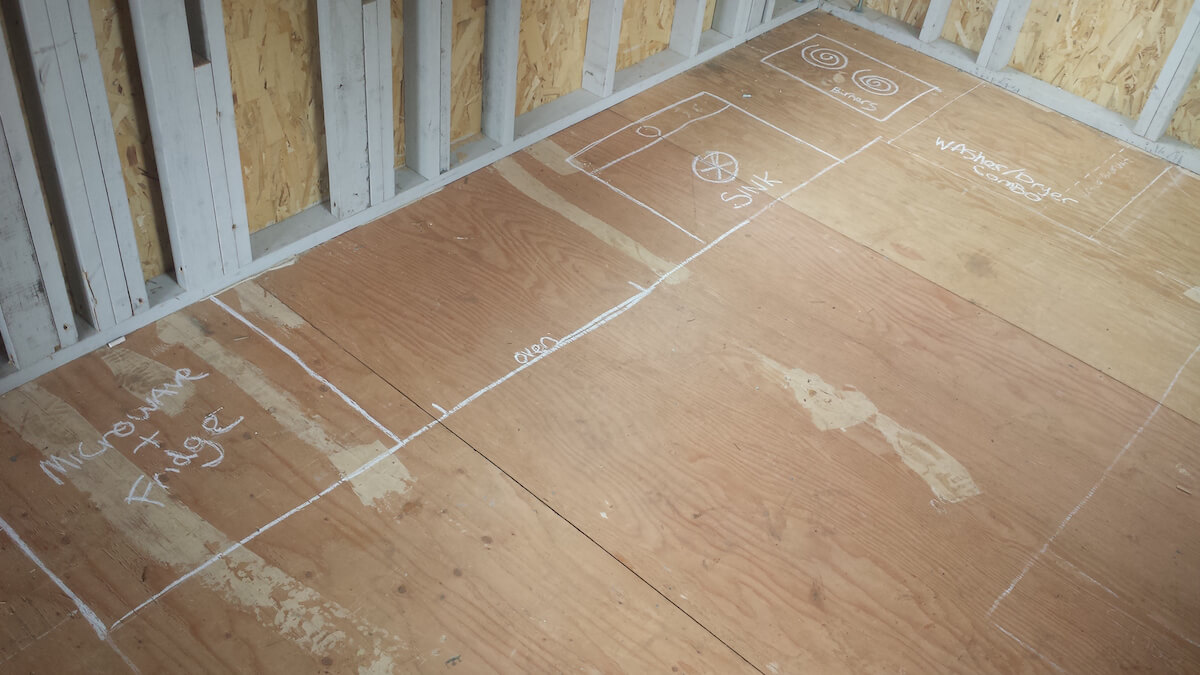
Use chalk or masking tape to outline your kitchen design on a flat surface to decide if you can work with the space limitations. This physical outline reveals much more than paper, as it makes the space more real.
Again, this exercise is most helpful before you build!
Visit A Friend’s Boat Or RV
See if you know anyone with a sailboat or an RV. The kitchens in tiny houses closely resemble those on sailboats and RVs. Ask your friend if you can cook a meal in their kitchen. If you like what you experience, take ideas from the design and apply them to your tiny house. AirBnb could be a resource for finding a place if you don’t know anyone.
Speaking of sailboats and RV’s, tiny house builders often use items specialized for sailboats and RV’s in their tiny house. The combo kitchen units sold to RV and boat-owners are good for tiny houses since they’re relatively cheap, and offer a sink, cooking platform, refrigerator, and storage all in one unit.
Double Check Your Ventilation Situation
An overlooked essential every tiny house kitchen needs: ventilation! We can’t stress this enough, you must make sure you have adequate ventilation in both your kitchen and your bathroom. Tiny houses have moisture problems due to their small area. Consider installing a range hood, dehumidifier, and/or air exchanger. You’ll come across tons of half-baked ideas on how to reduce moisture—for example, amassing thousands of silicon packets from beef jerky packages is not an effective or environmentally-friendly way to reduce moisture.
Designing a tiny house is like solving a puzzle—For some puzzles are a source of bottomless frustration for others to the point where they try to find ways to cheat. Don’t cut corners, or you could end up with a kitchen that’s about as useful as a Rubix Cube with half of its stickers removed. But if you love solving puzzles, (and you follow my recommendations) you’ll love designing, building, and cooking in your tiny house kitchen.

